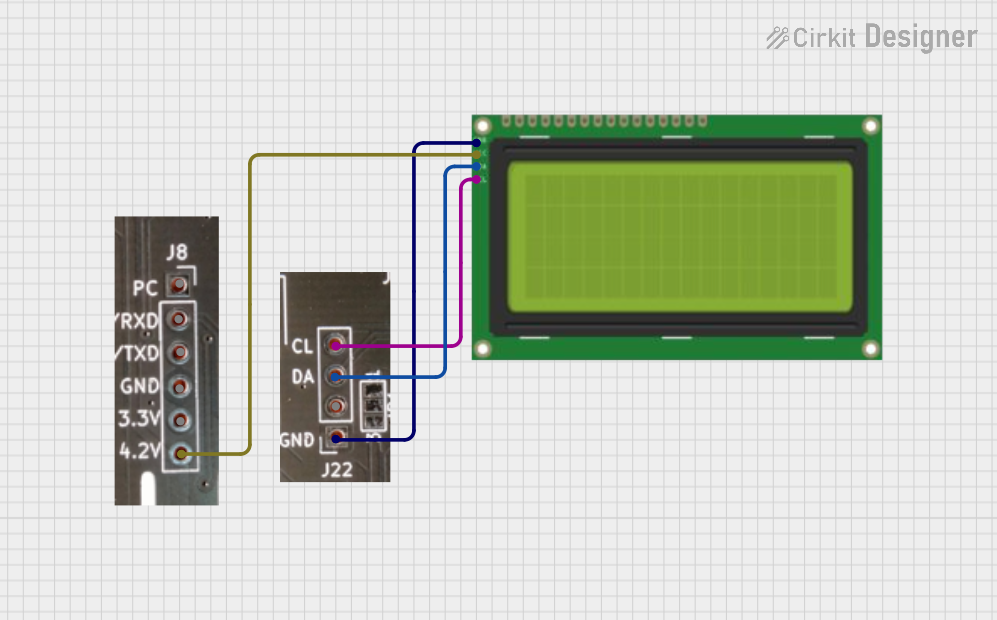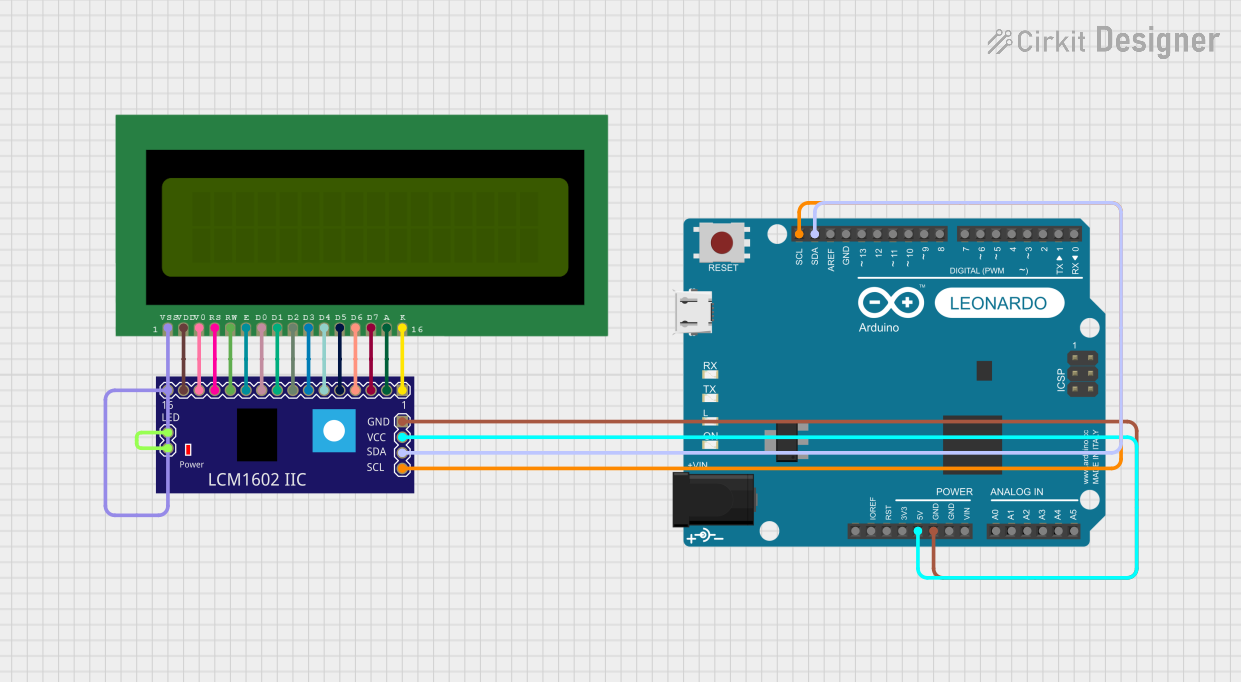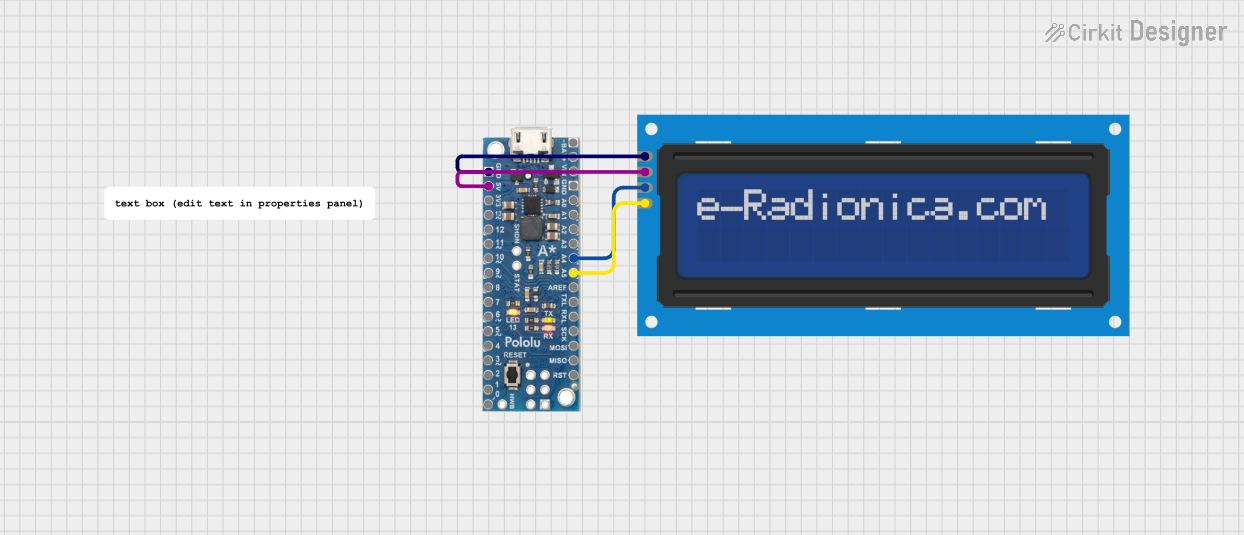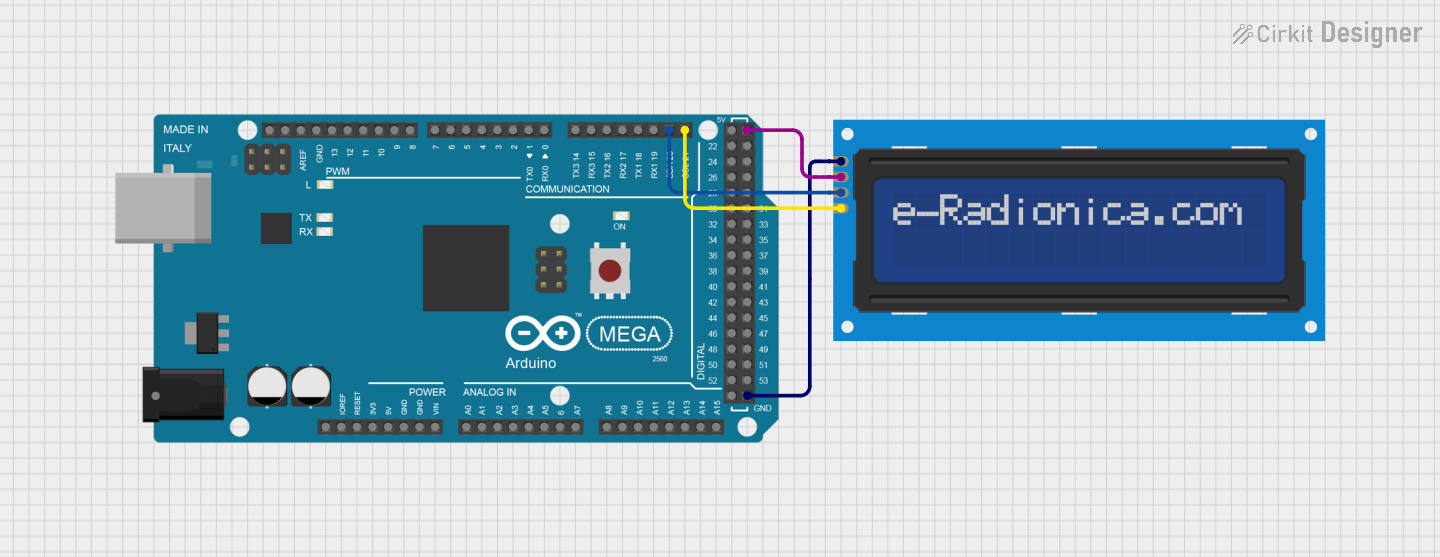
How to Use LCD 16x2 attached i2c: Examples, Pinouts, and Specs

 Design with LCD 16x2 attached i2c in Cirkit Designer
Design with LCD 16x2 attached i2c in Cirkit DesignerIntroduction
The LCD 16x2 with I2C interface is a versatile and widely used display module capable of showing 16 characters per line across 2 lines. It is equipped with an I2C (Inter-Integrated Circuit) interface, which simplifies communication with microcontrollers by reducing the number of required pins. This makes it an excellent choice for projects where pin availability is limited or where simplicity is desired.
Explore Projects Built with LCD 16x2 attached i2c

 Open Project in Cirkit Designer
Open Project in Cirkit Designer
 Open Project in Cirkit Designer
Open Project in Cirkit Designer
 Open Project in Cirkit Designer
Open Project in Cirkit Designer
 Open Project in Cirkit Designer
Open Project in Cirkit DesignerExplore Projects Built with LCD 16x2 attached i2c

 Open Project in Cirkit Designer
Open Project in Cirkit Designer
 Open Project in Cirkit Designer
Open Project in Cirkit Designer
 Open Project in Cirkit Designer
Open Project in Cirkit Designer
 Open Project in Cirkit Designer
Open Project in Cirkit DesignerCommon Applications and Use Cases
- Displaying sensor data in real-time
- User interfaces for embedded systems
- Menu systems for microcontroller-based projects
- Educational and prototyping purposes
- IoT devices requiring a simple display
Technical Specifications
Key Technical Details
- Display Type: 16x2 character LCD
- Interface: I2C (uses PCF8574 I/O expander)
- Operating Voltage: 5V DC
- Backlight: LED backlight with adjustable brightness
- I2C Address: Typically
0x27or0x3F(configurable via jumpers) - Current Consumption: ~20mA (with backlight on)
- Character Size: 5x8 dot matrix per character
- Operating Temperature: -20°C to 70°C
Pin Configuration and Descriptions
The I2C interface reduces the number of pins required to just four. Below is the pin configuration:
| Pin Name | Description |
|---|---|
| VCC | Power supply (5V DC) |
| GND | Ground |
| SDA | Serial Data Line (I2C data) |
| SCL | Serial Clock Line (I2C clock) |
Usage Instructions
How to Use the Component in a Circuit
Wiring the LCD to a Microcontroller:
- Connect the
VCCpin to the 5V pin of the microcontroller. - Connect the
GNDpin to the ground (GND) of the microcontroller. - Connect the
SDApin to the I2C data pin of the microcontroller (e.g., A4 on Arduino UNO). - Connect the
SCLpin to the I2C clock pin of the microcontroller (e.g., A5 on Arduino UNO).
- Connect the
Install Required Libraries:
- For Arduino, install the
LiquidCrystal_I2Clibrary via the Library Manager in the Arduino IDE.
- For Arduino, install the
Basic Arduino Code Example: Below is an example code to display "Hello, World!" on the LCD:
// Include the LiquidCrystal_I2C library #include <Wire.h> #include <LiquidCrystal_I2C.h> // Initialize the LCD with I2C address 0x27 and 16x2 dimensions LiquidCrystal_I2C lcd(0x27, 16, 2); void setup() { lcd.begin(); // Initialize the LCD lcd.backlight(); // Turn on the backlight lcd.setCursor(0, 0); // Set cursor to the first column, first row lcd.print("Hello, World!"); // Print text on the LCD } void loop() { // No actions in the loop for this example }
Important Considerations and Best Practices
- I2C Address: Ensure the correct I2C address is used. If the LCD does not respond, use an I2C scanner sketch to detect the address.
- Power Supply: Use a stable 5V power source to avoid flickering or malfunction.
- Contrast Adjustment: The contrast of the display can be adjusted using the potentiometer on the I2C module.
- Backlight Control: The backlight can be turned on or off programmatically using the
lcd.backlight()andlcd.noBacklight()functions.
Troubleshooting and FAQs
Common Issues and Solutions
LCD Not Displaying Anything:
- Verify the wiring connections.
- Check the I2C address and ensure it matches the one in the code.
- Ensure the contrast is properly adjusted using the potentiometer.
Flickering or Unstable Display:
- Ensure the power supply is stable and sufficient (5V DC).
- Check for loose connections in the circuit.
Incorrect or Garbled Characters:
- Verify the I2C address and ensure no other devices on the I2C bus are causing conflicts.
- Ensure the correct library is installed and used.
Backlight Not Working:
- Check the backlight jumper on the I2C module.
- Use the
lcd.backlight()function in the code to enable the backlight.
FAQs
Q: How do I find the I2C address of my LCD?
A: Use an I2C scanner sketch to detect the address. This sketch is widely available online and can be run on your microcontroller.Q: Can I use this LCD with a 3.3V microcontroller?
A: Yes, but you may need a level shifter for the I2C lines to ensure proper communication.Q: Can I display custom characters on this LCD?
A: Yes, theLiquidCrystal_I2Clibrary supports custom characters. Refer to the library documentation for details.Q: What is the maximum cable length for I2C communication?
A: The maximum length depends on the pull-up resistors and the speed of communication, but typically it is recommended to keep the length under 1 meter for reliable operation.
By following this documentation, you should be able to successfully integrate and use the LCD 16x2 with I2C in your projects!